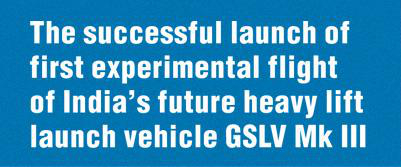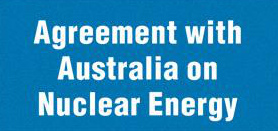Space, Nuclear Claims Based On Past Work
#NDAOneYear #SaalEkShuruaatAnek : we continue our series on key achievements of govt, with ISRO : pic.twitter.com/IoOr2ZBnch
— PIB India (@PIB_India) May 26, 2015An analysis of the claims made by the National Democratic Alliance government, after a year in office, regarding achievements in space and atomic energy, reveals that work on many projects, including the launch of Mars Orbiter and the commercial operation of Kudankulam nuclear power plant, began several years ago.
We emailed our findings to the ministry last week, requesting comment. There was no response.
1. Successful launch of Mars Orbiter spacecraft: Yes, but it was conceptualised and launched earlier
Claim: Mars Orbiter spacecraft successfully inserted into Mars orbit on September 24, 2014, declared a “key achievement”.

Check Revealed: The timeline of Mars Orbiter is as follows:
i. Indian Space Research Organisation (ISRO) conducted detailed technical and scientific studies from August 2010 and released a report in June 2011.
ii. Work on the project started after it was formally approved by the government in August 2012.
iii. Mars Orbiter Mission (MOM), popularly known as Mangalyaan, was successfully launched on November 5, 2013, onboard PSLVC25 from Satish Dhawan Space Centre, Sriharikota.
iv. MOM was successfully inserted into Mars orbit on September 24, 2014.
After the MOM was successfully launched in November 2013, the next milestone planned was its insertion into the Mars orbit. That was achieved in September 2014. So, the current government had a very limited role to play in the Mars mission.
2. Launch of GSLV MK-III: Yes, but after 13 years of work
Claim: Successful first experimental flight of India’s future heavy-lift launch vehicle GSLV Mk-III.

Check Revealed: The timeline of Geosynchronous Satellite Launch Vehicle Mark III (GSLV MK-III) development is as follows:
i. The GSLV Mk-III project was approved in 2002 with an outlay of Rs 2,498 crore. The first developmental flight of GSLV Mark 3 was originally targeted for the year 2008.
ii. The GSLV programme faced a few failures between 2006 and 2010, before a review was done and improvements made.
iii. In January 2014, GSLV Mk-II achieved success. In February 2014, the budget for GSLV MK-III was revised and the government gave an additional Rs 465 crore.
iv. In December 2014, an experimental test-flight of GSLV MK-III launched a communication satellite.
While the GSLV MK-III project did meet a lot of milestones during 2014-15, the planning, implementation and reviews of the project conducted since 2002 should also be considered while assessing the success of the project.
3. Third regional navigational satellite IRNSS-1C launched: Part of an ongoing plan
Claim: India’s Polar Satellite Launch Vehicle (PSLV-C26) successfully launched India’s third satellite IRNSS-1C.

Check Revealed: The establishment of an independent Indian Regional Navigation Satellite System (IRNSS) with a constellation of seven satellites was to be originally realised during the 11th Plan. IRNSS is designed to provide a position accuracy better than 10-metres over India and the region, extending about 1,500 km around India.
The estimated budget for seven satellites with two spare satellites and the associated ground segment is Rs 1,420 crore. The launch cost of seven satellites using PSLV is Rs 630 crore, the total project cost Rs 2,050 crore.
| Navigational Satellite | Launch Vehicle | Date of Launch |
|---|---|---|
| IRNSS-1A | PSLV-C22 | July 1, 2013 |
| IRNSS-1B | PSLV-C24 | April 4, 2014 |
| IRNSS-1C | PSLV-C26 | October 16, 2014 |
| IRNSS-1D | PSLV-C27 | March 28, 2015 |
| IRNSS-1E | Planned in August 2015 | |
| IRNSS-1F | Planned in December 2015 | |
| IRNSS-1G | Launch planned in May 2016 |
Source: ISRO
| Budgetary Allocations for IRNSS (in Rs crore) | ||||
|---|---|---|---|---|
| Sanctioned Cost | Expenditure up to end of March 2012 | Budget 2012-13 | Revised 2012-13 | Budget 2013-14 |
| 1420 | 743.7 | 170 | 134.2 | 135 |
Source: Outcome Budget Of The Department Of Space, Government Of India 2013-2014
4. Kudankulam Nuclear Power Project (KNPP) commercial operation: Construction started 13 years ago
Claim: Unit 1 of KNPP-1 commenced commercial operation, “key achievement of the current government”.
#NDAOneYear : Achievements of Dept of Atomic Energy.. pic.twitter.com/T1ZKuGyGB7
— PIB India (@PIB_India) May 26, 2015Check Revealed: The timeline of the nuclear plant demonstrates that all the major milestones of the project were achieved before the current government came into power:
i. Construction started in March 2002 with technical cooperation from the Russian Federation. The project was delayed due to the late delivery of equipment from Russia.
ii. The cost of the Kudankulam nuclear project was Rs 13,171 crore and the project was scheduled to be completed in phases by December 2007 and December 2008. Unit-1 of the project attained first criticality (controlled self-sustaining fission chain reaction) on July 13, 2013.
iii. Unit-1 finally commenced commercial operation on December 31, 2014.
(Sources: Rajya Sabha Unstarred Question No. 2803, Answered On 20.02.2014 ; Unstarred Question No. 1400 Answered On 22.08.2013 and Unstarred Question No. 2802, Answered On 20.02.2014)
5. Agreement with Australia on Nuclear Energy: The work of several years
Claim: India-Australia sign bilateral nuclear cooperation agreement.

Check Revealed: The agreement is a result of the work of several years; the timeline is as follows:
i. India’s nuclear isolation ends with the bilateral nuclear trade agreement with USA in 2007.
ii. In August 2008, the board of International Atomic Energy Agency (IAEA) approved a nuclear safeguards agreement with India and in February 2009, an agreement between the Government of India and the IAEA for the application of safeguards to civilian nuclear facilities was signed.
iii. In September 2008, India was exempted from existing nuclear trade restrictions maintained by the 45-member Nuclear Suppliers Group (NSG), allowing India to acquire nuclear technology and material.
iv. Following the NSG decision, India signed bilateral civil-nuclear cooperation agreements with France, USA, Russia, Namibia, Mongolia, UK, Canada, Argentina, Kazakhstan, Republic of Korea and Czech Republic.
v. In Dec 2011, Australia reversed its ban on selling uranium to India.
vi. During the state visit of Australian Prime Minister to India in October 2012, the Indian and Australian Prime Ministers announced that the two countries would negotiate terms of a bilateral civil-nuclear cooperation agreement.
vii. Bilateral civil-nuclear energy cooperation agreement was on agenda during the 14th India-Australia Joint Ministerial Commission (JMC) Meeting that was held on January 29, 2013 in New Delhi.
viii. The first round of discussions was held in New Delhi in March 2013 and the second round in July 2013.
ix. Finally, on September 5, 2014, India and Australia signed an MoU for ‘Cooperation in the Peaceful Uses of Nuclear Energy’ during the Australian Prime Minister’s visit to India.
So, the current government cannot take full credit for signing the India-Australia civil nuclear agreement.
The series has concluded. You can read earlier stories from the series below:
1) Overblown, Misleading Claims By 14 Modi Ministries
2) Agriculture Ministry: Old Schemes Renamed, Other Misleading Claims
3) Health Ministry: New Claims, No New Programmes
4) Power Ministry: Marginal Improvements
5) Railway Ministry: 8 Achievements That Really Aren’t
6) Road Transport Ministry: Continues UPA’s Work, Contradicts Own Data
7) Telecom Ministry: Wrong Claims, Bad Maths
8) Sanitation Ministry: Old Wine, New Bottles
9) Department Of Posts: Old Plans On Track
10) Textiles Ministry: Achievements, Carried Over
11) Tourism Ministry: Unexceptional Claims
12) Ganga Rejuvenation: Many Attempts Over 30 Years
13) Food Processing Ministry: Government Claims More Projects Than Sanctioned
14) Rural Development Ministry: Key Scheme Renamed, Funds Cut
(Manoj K is a graduate of the Indian Institute of Technology, Delhi, and the founder of the Centre for Governance and Development. He has a special interest in transparency and accountability in governance and has spearheaded several projects on these subjects. He can be contacted at manoj@cgdindia.org.)
References: Fact Check 1
1. Lok Sabha: http://164.100.47.132/LssNew/psearch/QResult15.aspx?qref=126943
Fact Check 2
1. Lok Sabha: http://164.100.47.132/LssNew/psearch/QResult13.aspx?qref=51977
2. Lok Sabha: http://164.100.47.132/LssNew/psearch/QResult15.aspx?qref=107968
3. Department of Space, via PIB: http://pib.nic.in/newsite/PrintRelease.aspx?relid=104348
Fact Check 3
1. Department of Science & Technology: http://dst.gov.in/about_us/11th-plan/rep-space.pdf
2. Lok Sabha: http://164.100.47.132/LssNew/psearch/QResult15.aspx?qref=146154
3. ISRO: http://irnss.isro.gov.in/
4. Department of Space: http://performance.gov.in/sites/default/files/departments/space/Outcome Budget 2013-14.pdf
Fact Check 4
1. Rajya Sabha: Unstarred Question No. 2803, Answered On 20.02.2014
2. Rajya Sabha: Unstarred Question No. 1400 Answered On 22.08.2013
3. Rajya Sabha: Unstarred Question No. 2802, Answered On 20.02.2014
Fact Check 5
1. IAEA: https://www.iaea.org/newscenter/news/iaea-board-approves-india-safeguards-agreement
2. IAEA: https://www.iaea.org/newscenter/news/india-safeguards-agreement-signed
3. The Hindu: http://www.thehindu.com/todays-paper/tp-opinion/goodbye-to-nuclear-export-controls/article1334655.ece
4. Lok Sabha: http://164.100.47.132/LssNew/psearch/QResult15.aspx?qref=108271
5. IDSA: http://www.idsa.in/idsacomments/AustraliasUraniumExporttoIndiaandPakistansClaim_cvsastry_141211.html
6. Department of Atomic Energy, via PIB: http://pib.nic.in/newsite/PrintRelease.aspx?relid=97800
7. Rajya Sabha, via PIB: http://pib.nic.in/newsite/erelease.aspx?relid=93103
8. The Hindu: http://www.thehindu.com/news/national/firstever-talks-on-nuclear-partnership-with-australia-soon/article4328869.ece
9. The Economic Times: http://articles.economictimes.indiatimes.com/2013-07-12/news/40536596_1_uranium-sale-australian-uranium-peaceful-purposes
10. Prime Minister’s Office, via PIB: http://pib.nic.in/newsite/PrintRelease.aspx?relid=109379


